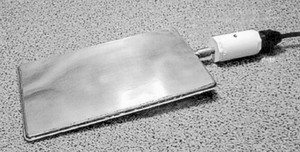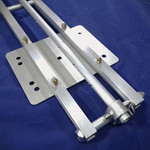 Loading... Please wait...
Loading... Please wait...Hydrological Equipment
- Home
- Sediment Sampling Equipment
- Scour Sensors
- USGS Load Cell Scour Sensor
The Load-Cell Scour Sensor is sensitive to small changes in sediment load and can measure infilling of gravel and cobbles with fine-grained sediment. Ideal uses for the sensor include (1) shallow placement in spawning beds of fish for unattended monitoring of deposition, erosion and substrate temperature, (2) monitoring transport of bedforms in experimental flumes, and (3) monitoring scour at bridge piers or similar structures.
The load-cell sensor weighs the sediment, water, and air above it, and an accompanying pore-pressure sensor weighs the water and air above it. The difference between the two weights is the weight of the sediment overlying the sensor pair. Combined sensitivity and repeatability are ±0.01 foot of sediment thickness or less. A temperature sensor in the pressure-sensor housing provides useful information about the spawning-bed and sensor environment and enables calibration of the pressure sensors to ±0.02 percent of the full-scale output.
The sensor can be buried or jetted into cohesion sediment such as a sandbar. The deeper the sensor is buried, the safer it is from being scoured and the larger the area it averages. The shallower the sensor, the greater the detail that can be determined from closely spaced sensors, but the greater the risk of removal by scour.
The sensor also works on its side, with the foil in a vertical plane, because changes in horizontal stress (with a coefficient of about 0.3) in sediment accompany changes in vertical stress (weight per unit area) that are caused by scour and deposition.
The load-cell sensor can provide unattended measurement and documentation of scour, deposition, and sediment transport in ephemeral streams. Installation of multiple sensors in two or more closely spaced cross sections will enable automated slope-area determinations of discharge and establishment of rating curves at sites in sand channels that are inaccessible during flow. Additional uses of the sensor include scour at bridge piers and similar structures, studies of liquefaction or quicksand, and beach erosion.
The load-cell scour sensor consists of a shallow, stamped 10 inch by 6 inch rectangular stainless steel vessel, and the sensors are tested to 30 pounds per square inch and can be buried to a depth of 40 feet. Sensor output cables come in 50 ft. standard lengths with a 4-20 ma signal to a datalogger.






